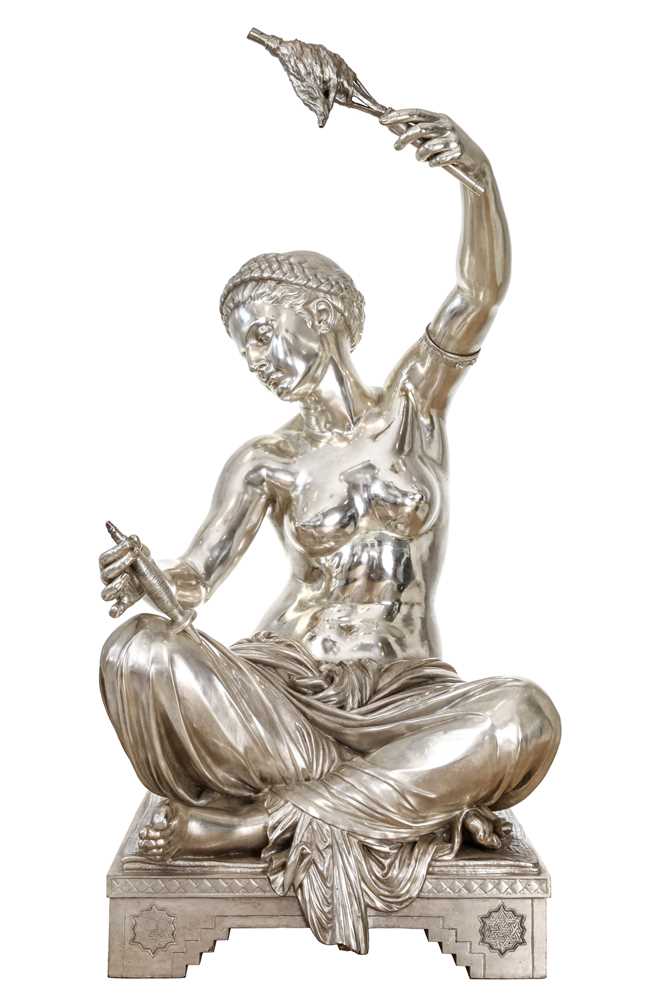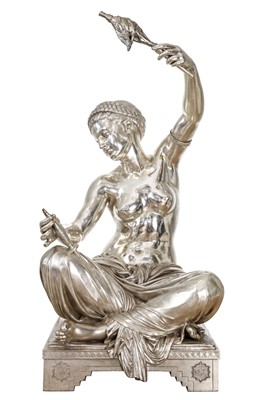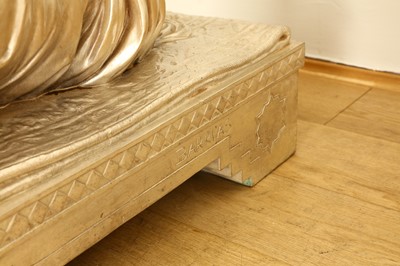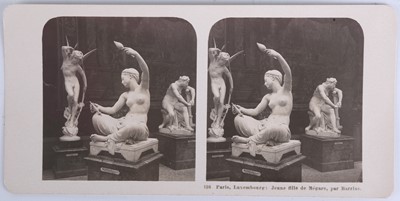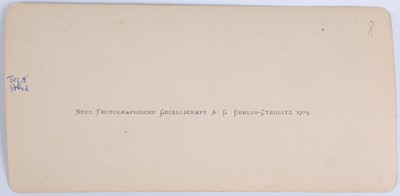21st Mar, 2018 10:00
European Works of Art & Clocks
LOUIS-ERNEST BARRIAS (FRENCH, 1841-1905): AN EXCEPTIONAL LIFE SIZE SILVERED BRONZE FIGURE OF A GIRL SPINNING 'LA JEUNE FILLE DE MEGARE' EXHIBITED AT THE VIENNA INTERNATIONAL EXHIBITION OF 1873, CAST BY THIEBAUT & FILS the youthful nude raised on a plinth modelled as a low stool, signed to the right side 'BARRIAS', and inscribed 'FDU PAR VOR. THIEBAULT & FILS', sold together with a photographic print showing two stills of the marble version, titled ‘116 Paris, Luxembourg: Jeane fille de Megare, par Barrias’, inscribed to the reverse ‘NEUE PHOTOGRAPHISCHE GESELLSCHAFT A.G. BERLIN-STGLITZ 1903’, (18cm wide x 9cm high) 126cm high x 66cm wide THIS LOT WILL BE ON DISPLAY AT OUR SOUTH KENSINGTON GALLERY UNTIL 14TH MARCH AND AT OUR CHISWICK SALEROOM FROM 16TH - 21ST MARCH. PROVENANCE: Purchased by the present owner from a gallery in Switzerland around forty years ago. FOOTNOTE: This exceptional master work by one of the most important sculptors of the 19th century has been in private hands for a generation and its re-emergence into the art world provides a rare opportunity to acquire a truly museum-worthy work of art. The identical marble figure of the 'Jeune Fille de Megare', which is the same size as the silvered bronze and was exhibited at the same time, is now in the Musee D'Orsay, Paris. 'La Jeune Fille de Megare' came relatively early in Barrias's illustrious career. Having studied at the Ecole des Beaux-Arts, Paris, he won the prestigious Prix de Rome in 1864, which entitled him to study at the French Academy in Rome, then based at the Villa Medici. It is here, surrounded by ancient marbles and classical works that he first began work on this seminal sculpture. The influence of the ancient world is apparent not only in the theme but in the stylistic qualities of the sculpture. 'La Jeune Fille de Megare' depicts a seated youthful girl spinning, for wool production was the main export of her home; the small Greek port town of Magara, in ancient times. She is depicted nude, but not in any overtly erotic sense; for her pose is refined, static and balanced in the classical tradition; her gaze is measured and her gestures are graceful and poised. She is seated on a low stool designed in the Neo-Classical taste and is depicted as an idealised beauty rather than as a portrait of a particular girl. Her features are generalised and finely proportioned, and she performs a simple, every day act but with a graceful movement that emphasises her female form. Barrias initially produced a plaster version of his spinning girl in 1867, it was presumably this model that he sent to Thiebaut & Fils, arguably the best bronze founder in Paris at that time, to be cast in bronze and silvered. In 1870 he had finished the full size marble version, which is of identical form and size to the present lot. He sent the marble figure to the Paris Salon of 1870, where it was widely admired, to such an extent that it was purchased by the state (decree of 8/06/1870, acquired for 6000 F at the Salon of 1870). It was then exhibited at the Luxembourg Museum in 1872, before being sent by the state to the Vienna International Exhibition of 1873, where it was paired with the present lot. The official catalogue entry of the 1873 exhibition lists the works as follows: Barrias Ernest Louis, geb. Zu Paris, Schuler von Cavelier und Jouffroy, Paris, avenue Montaigne 37. 831 Die Spinnerin von Megara, Statue aus versilberter Bronze. 832 Die Spinnerin von Megara, Marmor-Statue. Staatseigenthum (public property) ‘Die Spinnerin vo Megara, Statue aus versilberter Bronze’ translates as ‘The Spinner from Megara, silvered bronze statue’, and records show that it was this sculpture, the present lot, that won Barrias the Art Medal at the exhibition. The marble spinning girl 'Die Spinnerin', was subsequently exhibited by the state at the Paris Exposition Universelle of 1878, and then returned to the Luxembourg Museum; and it appears in a 1903 photographic print whilst on display there, which is sold together with the present lot. In 1923 the marble version was moved to the Louvre, where it remained until 1986 when it was moved to its current location at the Musee d'Orsay. Barrias's continued admiration of 'La Jeune Fille de Megare' is confirmed by his re-interpretation of the composition for his study of a young Algerian girl entitled 'Jeune Fille de Bou-Saada'. Seated cross legged on a similar low stool, the young girl from Bou-Saada raises her right arm rather than her left, and is elaborately dressed in fine, jewelled clothes. The sculpture depicts a young Algerian girl, fully clothed, wearing a headdress and holding flowers, whilst raised on a base modelled as a rug over the low stool plinth. No longer surrounded by the marbles of ancient Rome, back in Paris Barrias was instead inspired by the fashion for Orientalism, and other influences for this later work include Achille Guillaumet's painting of 1885 entitled 'La Carieuse de aine de Bou-Saada' (Musée des Beaux Arts, Rouen). The obvious differences between these two canonical works by the sculptor clearly illustrate the stylistic journey that he took from the refined Neo-Classical style at the beginning of his career, to the exotic, emotive Romanticism that he embraced by the 1880's and which is apparent in the 'Jeune Fille de Bou-Saada'. Barrias worked his Jeune Fille de Bou-Saada first in wax and exhibited it at the Paris Salon of 1890, later producing a full size marble version, which can be seen in a photograph of this time showing the sculptor in his studio. A bronze version of the Bou-Saada was also made for a funerary monument at Montmartre cemetery, and the sculptor subsequently worked with the Susse Freres bronze foundry to produce an edition of the model in various sizes and materials, such as chryselephantine, enamelled and gilt bronze. Even the use of these more colourful and exotic materials employed in the various versions of the Jeune Fille de Bou-Saada reflect a change in the sculptors artistic goals, from the elegant idealism of the present silvered bronze which as a material reflects light and gives an ethereal look to the finely chiselled surface, to the much more exuberant and exotic appearance of this later work. Reductions of the 'Jeune Fille de Bou-Saada', mostly cast by the Susse Freres foundry, have come to auction in recent years, and the prices realised even for these smaller reductions reflect the continued admiration for the sculptor's work. For example a bronze and ivory of the Bou Saada girl at 33cm high and cast by Susse Freres was sold at Sotheby's, London, 30 May, 2008, lot 117, for £34,000. Reductions of the present sculpture were never made, and so no other examples have ever come to auction. The re-emergence of this exhibition piece therefore presents a unique opportunity to acquire a work of true art historical importance by this renowned sculptor. Related Literature: Universal Exhibition (1873, Wien) Officieller Kunst-Catalog - Wien, 1873 Welt-Ausstellung 1873 in Wien, Verl. der General-Direction, 1873. Le rapport de la Commission supérieure fournit la liste des sculptures françaises exposées à Philadelphie en 1876 [viii] states that Barrias won the medal for Art for the Megara Spinner, silvered bronze statue. A. Pingeot , The Norman-Roman Antoinette - Margerie Laure, Musée d'Orsay. Illustrated Summary Catalog of Sculptures, Paris, 1986 Bonfait Olivier [ed.], Maesta di Romà. Da Napoleone all'unità d'Italia. From Ingres to Degas. French artists in Rome., Rome, 2003.
Sold for £32,500
Includes Buyer's Premium
Do you have an item similar to the item above? If so please click the link below to submit a free online valuation request through our website.
